Cerebral amyloid angiopathy-related inflammation presenting with steroid-responsive higher brain dysfunction: case report and review of the literature
- PMID: 21914214
- PMCID: PMC3185269
- DOI: 10.1186/1742-2094-8-116
Cerebral amyloid angiopathy-related inflammation presenting with steroid-responsive higher brain dysfunction: case report and review of the literature
Abstract
A 56-year-old man noticed discomfort in his left lower limb, followed by convulsion and numbness in the same area. Magnetic resonance imaging (MRI) showed white matter lesions in the right parietal lobe accompanied by leptomeningeal or leptomeningeal and cortical post-contrast enhancement along the parietal sulci. The patient also exhibited higher brain dysfunction corresponding with the lesions on MRI. Histological pathology disclosed β-amyloid in the blood vessels and perivascular inflammation, which highlights the diagnosis of cerebral amyloid angiopathy (CAA)-related inflammation. Pulse steroid therapy was so effective that clinical and radiological findings immediately improved.CAA-related inflammation is a rare disease, defined by the deposition of amyloid proteins within the leptomeningeal and cortical arteries associated with vasculitis or perivasculitis. Here we report a patient with CAA-related inflammation who showed higher brain dysfunction that improved with steroid therapy. In cases with atypical radiological lesions like our case, cerebral biopsy with histological confirmation remains necessary for an accurate diagnosis.
Figures



References
-
- Oh U, Gupta R, Krakauer JW, Khandji AG, Chin SS, Elkind MS. Reversible leukoencephalopathy associated with cerebral amyloid angiopathy. Neurology. 2004;62(3):494–497. - PubMed
-
- Scolding NJ, Joseph F, Kirby PA, Mazanti I, Gray F, Mikol J, Ellison D, Hilton DA, Williams TL, MacKenzie JM. et al.Abeta-related angiitis: primary angiitis of the central nervous system associated with cerebral amyloid angiopathy. Brain. 2005;128(Pt 3):500–515. - PubMed
Publication types
MeSH terms
Substances
LinkOut - more resources
Full Text Sources
Other Literature Sources
Medical

